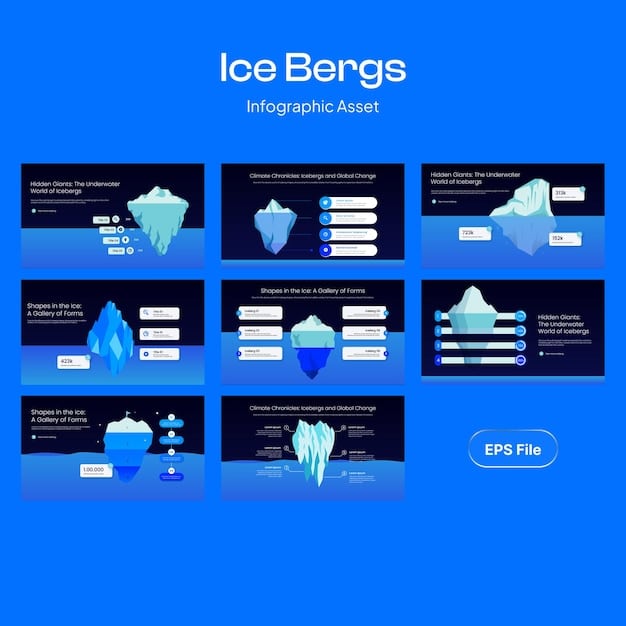Optimize Cloud Storage Costs: AWS S3 Glacier Deep Archive Guide

Optimizing cloud storage costs with AWS S3 Glacier Deep Archive involves understanding its features, implementing best practices for data lifecycle management, and continuously monitoring storage usage to minimize expenses while ensuring data durability and accessibility.
In today’s data-driven world, managing cloud storage costs is crucial for businesses of all sizes. The Optimize Cloud Storage Costs: A Practical Guide to AWS S3 Glacier Deep Archive provides a comprehensive guide to understanding and leveraging AWS S3 Glacier Deep Archive for long-term data storage and significant cost savings.
Understanding AWS S3 Glacier Deep Archive
AWS S3 Glacier Deep Archive is a low-cost storage class designed for archiving and long-term backup. It’s ideal for data that is rarely accessed but needs to be retained for compliance, regulatory, or business reasons. Let’s explore its core features and benefits.
Key Features of Glacier Deep Archive
Glacier Deep Archive offers secure, durable, and extremely low-cost cloud storage. Its design is optimized for infrequently accessed data while ensuring data integrity over the long term.
Benefits of Using Glacier Deep Archive
The primary benefit of Glacier Deep Archive is its cost-effectiveness for long-term data retention. It allows organizations to store vast amounts of data without incurring exorbitant storage expenses.
- Cost Savings: Reduce storage costs compared to standard S3 storage classes.
- Long-Term Durability: Ensure data integrity with AWS’s robust infrastructure.
- Compliance: Meet regulatory requirements for long-term data retention.
- Security: Protect data with AWS’s comprehensive security features.

By leveraging Glacier Deep Archive, businesses can free up resources and focus on more strategic initiatives. Understanding its features and benefits is the first step in optimizing cloud storage costs.
Assessing Your Data Storage Needs
Before diving into Glacier Deep Archive, a thorough assessment of your data storage needs is essential. This involves analyzing the type of data you store, how frequently it’s accessed, and how long it needs to be retained.
Identifying Suitable Data for Archiving
Not all data is suitable for Glacier Deep Archive. The ideal data is infrequently accessed, such as historical records, archives, and backups that need to be retained for compliance or auditing purposes.
Analyzing Data Access Patterns
Understanding how frequently your data is accessed helps determine if Glacier Deep Archive is the right choice. Data that is accessed less than once or twice a year is a good candidate.
- Determine Access Frequency: Use monitoring tools to track data access patterns.
- Categorize Data: Separate frequently accessed data from infrequently accessed data.
- Estimate Retention Period: Determine how long the data needs to be retained.
- Consider Retrieval Time: Understand the retrieval time requirements for archived data.
Effective data analysis is the cornerstone of a cost-effective storage strategy. By understanding your data’s lifecycle, you can make informed decisions about which data to archive and when.
Configuring AWS S3 Lifecycle Policies
AWS S3 Lifecycle policies automate the process of moving data between different storage classes, including Glacier Deep Archive. Configuring these policies ensures that data is automatically archived based on predefined rules.
Creating Lifecycle Rules
Lifecycle rules define the conditions under which objects are transitioned to different storage classes. These rules can be based on object age, creation date, or other metadata attributes.
Setting Transition Actions
Transition actions specify the storage class to which objects should be moved and the timing of the transition. For Glacier Deep Archive, the transition action typically involves moving data after a specified period of inactivity.

Implementing lifecycle policies streamlines data management and ensures that storage costs are automatically optimized. This reduces the need for manual intervention and minimizes the risk of human error.
Optimizing Data Retrieval from Glacier Deep Archive
While Glacier Deep Archive is ideal for long-term storage, it’s essential to understand the data retrieval process and how to optimize it. Retrieving data from Glacier Deep Archive can take several hours, so planning is crucial.
Understanding Retrieval Options
Glacier Deep Archive offers different retrieval options with varying speeds and costs. Expedited retrieval is the fastest but also the most expensive, while standard retrieval is more cost-effective but takes longer.
Best Practices for Data Retrieval
To optimize data retrieval, consider the following best practices:
- Plan Ahead: Anticipate data retrieval needs in advance.
- Use Standard Retrieval: Opt for standard retrieval unless expedited access is necessary.
- Batch Requests: Combine multiple retrieval requests to reduce overhead.
- Monitor Retrieval Costs: Track retrieval costs to identify potential optimizations.
Efficient data retrieval is crucial for maintaining business continuity and minimizing disruptions. By understanding the retrieval options and implementing best practices, you can ensure timely access to archived data without incurring unnecessary costs.
Monitoring and Analyzing Storage Costs
Continuous monitoring and analysis of storage costs are essential for identifying opportunities for optimization. AWS provides tools and services that allow you to track storage usage, identify cost drivers, and make informed decisions about storage management.
Using AWS Cost Explorer
AWS Cost Explorer provides detailed insights into your storage costs, allowing you to analyze spending trends and identify areas where you can save money. It offers customizable reports and visualizations to track storage usage and costs over time.
Implementing Cost Allocation Tags
Cost allocation tags allow you to categorize and track storage costs by department, project, or application. By tagging your S3 objects, you can gain a better understanding of how storage costs are distributed across your organization.
Effective cost monitoring and analysis enable you to proactively manage your storage expenses and ensure that you’re getting the most value from Glacier Deep Archive. Regular monitoring helps identify inefficiencies and implement corrective measures to minimize costs.
Security and Compliance Considerations
Security and compliance are paramount when dealing with long-term data storage. Glacier Deep Archive offers robust security features and compliance certifications to protect your data and meet regulatory requirements.
Implementing Encryption
Encryption is a critical security measure that protects your data from unauthorized access. Glacier Deep Archive supports both server-side encryption (SSE) and client-side encryption (CSE) to ensure data confidentiality.
Ensuring Data Integrity
Data integrity is maintained through checksums and redundant storage. Glacier Deep Archive automatically verifies the integrity of your data and provides multiple copies to ensure long-term durability.
By prioritizing security and compliance, you can ensure that your archived data is protected and meets the necessary regulatory standards. Implementing encryption, access controls, and data integrity checks are essential steps in maintaining a secure and compliant storage environment.
| Key Point | Brief Description |
|---|---|
| 💰 Cost Savings | Reduce storage expenses with Glacier Deep Archive’s low-cost storage. |
| ⚙️ Lifecycle Policies | Automate data archiving using S3 Lifecycle policies. |
| 🛡️ Security | Ensure data protection with encryption and integrity checks. |
| 📊 Monitoring | Track storage costs and usage with AWS Cost Explorer. |
Frequently Asked Questions
AWS S3 Glacier Deep Archive is a low-cost storage option for long-term data archiving. It provides durable and secure storage for data that is infrequently accessed, offering significant cost savings compared to standard S3 storage.
You can move data to Glacier Deep Archive by configuring S3 Lifecycle policies. These policies automatically transition objects to Glacier Deep Archive based on predefined rules, such as object age or creation date.
Glacier Deep Archive offers different retrieval options with varying speeds and costs. Expedited retrieval is the fastest, while standard retrieval is more cost-effective but takes longer, typically several hours.
You can monitor your Glacier Deep Archive costs using AWS Cost Explorer. This tool provides detailed insights into your storage expenses, allowing you to track spending trends and identify areas for potential cost optimization.
Yes, Glacier Deep Archive offers robust security features and compliance certifications. It supports encryption, data integrity checks, and access controls to protect your data and meet regulatory requirements.
Conclusion
Optimizing cloud storage costs with AWS S3 Glacier Deep Archive involves understanding its features, implementing best practices for data lifecycle management, and continuously monitoring storage usage. By following these guidelines, organizations can significantly reduce their storage expenses while ensuring data durability and accessibility.





